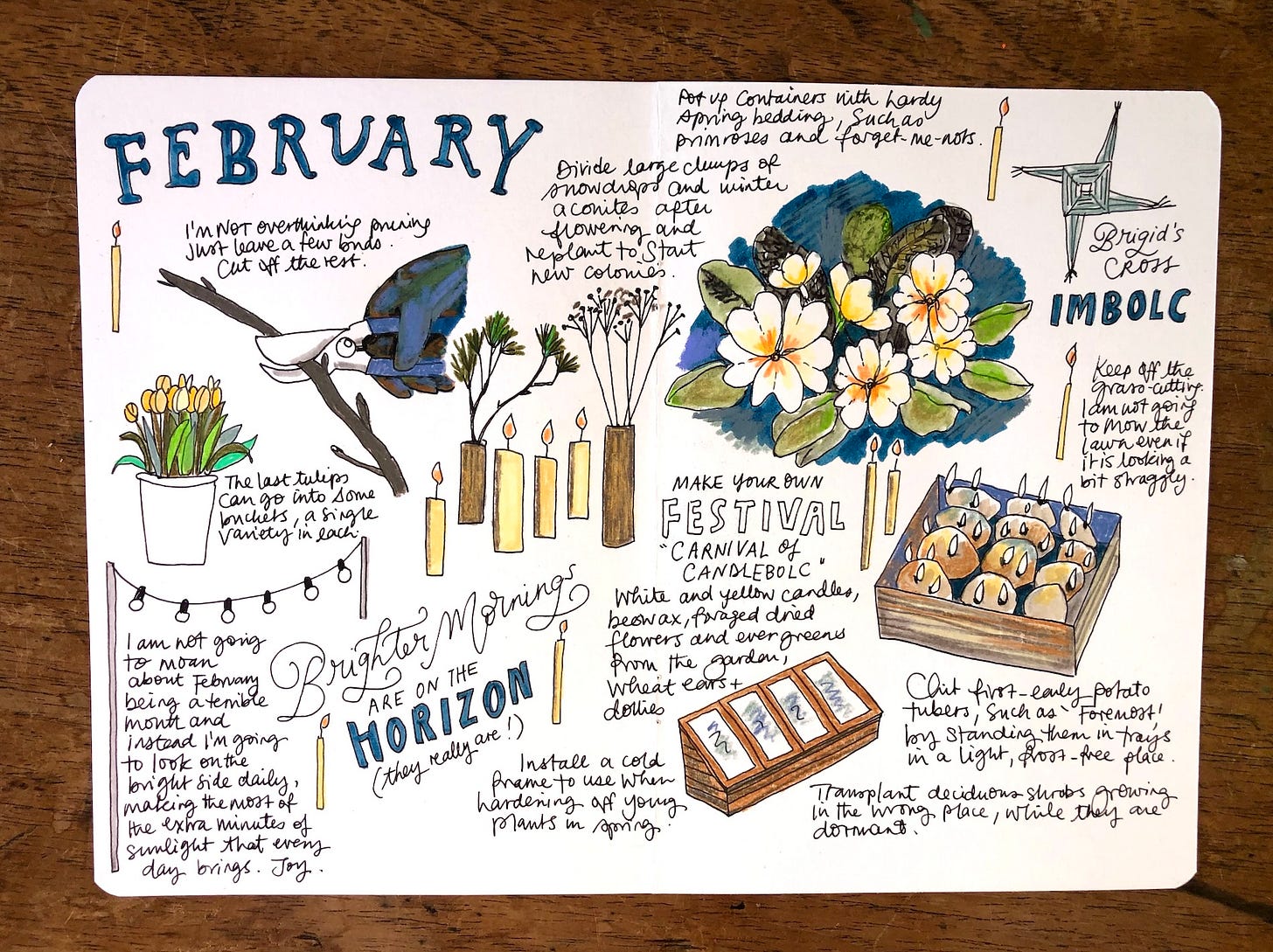How to garden in February
Let’s gather up a bit of get up and go. And it's Imbolc.
It’s that time again
Are you looking at all those to-do lists that seem to be launching themselves at us and feeling like all of a sudden there’s a mountain of to-dos? I’d recommend that the mission in February is to extract from them what we want to do, what needs doing, and, most importantly and the whole point of What Not To Do In Your Garden: those things which can be left well alone.
This is a tough list to make in February, and an even tougher one to stick to. Having been trapped inside by the cold, wet, wind and dark of January, frankly all we want to do is to get out there and get going, but it’s still a bit yuck out there.
And get going we will. Eventually. Don’t be overwhelmed by the to-do lists and don’t put pressure on yourself: think of everything as a pick and mix of opportunity.
Thank you for supporting The Gardening Mind. For over three years now, you have made it what it is, and each time you like a post by pressing the ❤️, it means that the word spreads. I’m really grateful: as the word spreads, The Gardening Mind reaches a new audience, many of whom are just dipping a toe into the world of gardening for the very first time.
This February there’s A LOT going on here - book publication, launch and talks, and at the same times as that there’s filming and planning for the RHS Chelsea Flower Show. So of course, I’m totally relaxed 😬 Thank you so much for supporting any or all of these: the dates are later in this post in the PS section, and you can pre-order The New Romantic Garden here:
The last of the tulips
I’m NOT worrying about the fact that I haven’t planted all my tulips yet. Yes it’s true: I still have a few packets lying around.The last ones can go into some buckets, a single variety in each, so that I can then move them around as they come into flower. They’ll probably be shorter than if I’d got them in the ground a month or so ago, but let’s not sweat the small stuff.
I’m not over-thinking pruning:
I am NOT going to get befuddled by wisteria pruning advice.
Every year, reading the instructions overwhelms me just a tiny bit and I always try to fob the task off to someone else. But it’s actually not as complicated as all the articles make it out to be. Essentially, in the summer you trim all the whippy flying-about shoots so that there are half a dozen or so leaves left.
Then, come February, when all these leaves will have dropped off, you can start to see some exciting little buds. Leave a couple of these on at the bottom of the stem, and cut off the rest. The official RHS advice is ‘Cut back wisteria side shoots to three buds from the base, to encourage abundant flowers in spring’.
Keep off the grass-cutting:
I am not going to mow my lawn even if it is looking a bit straggly. The soil underneath is still too muddy, and I’ll make a mess. I’m going to hold my nerve. I really am, even if we get a run of glorious sunshine.
I am not going to let my ornamental grasses start to shoot new growth without cutting back the old stems first:
To be honest, most of the stems have had their day and already been cut back, but some of them do need a bit of attention. I’m reminding myself that it’s just too fiddly a job to have to try to do this amongst the fresh new stems in a couple of month’s time. So no procrastinating, and chopping will be taking place very soon.
The same goes for epimedium: cut away all the old foliage before the spring flowers start to emerge.
Imbolc:
I am not going to moan about February being a terrible month: instead I’m going to look on the bright side daily, making the most of the extra minutes of sunlight that every day brings. The joy. I’ve created a daft festival of my own - a combination of Candlemas, Imbolc and Carnival: you can read about it here.
The snowdrops are out
Little pops of white magic everywhere - the sheer joy. Whether or not you have them in your own garden, getting out on a snowdrop walk is one of the most cheering things to do just when you feel there’s nothing really cheering about being outside. There are some snowdrop walks here - there’s also been some chat in the Chat about a snowdrop walk meet-up:
Later in the month, after your own snowdrops have flowered, divide any large clumps and pop them in another part of the garden. This way you’ll create new colonies of them and you’ll never regret the time you spent doing it. You can do the same with winter aconites.
Divide congested clumps of herbaceous perennials and grasses to make vigorous new plants for free. I always put off this job and then regret it in the summer. Let’s all divide our geraniums now!
Talking about jobs that you put off and then in summer regret not doing them, if you’ve got a deciduous shrub which you want to move, do it now. The plant is dormant so won’t be troubled by the uprooting.












